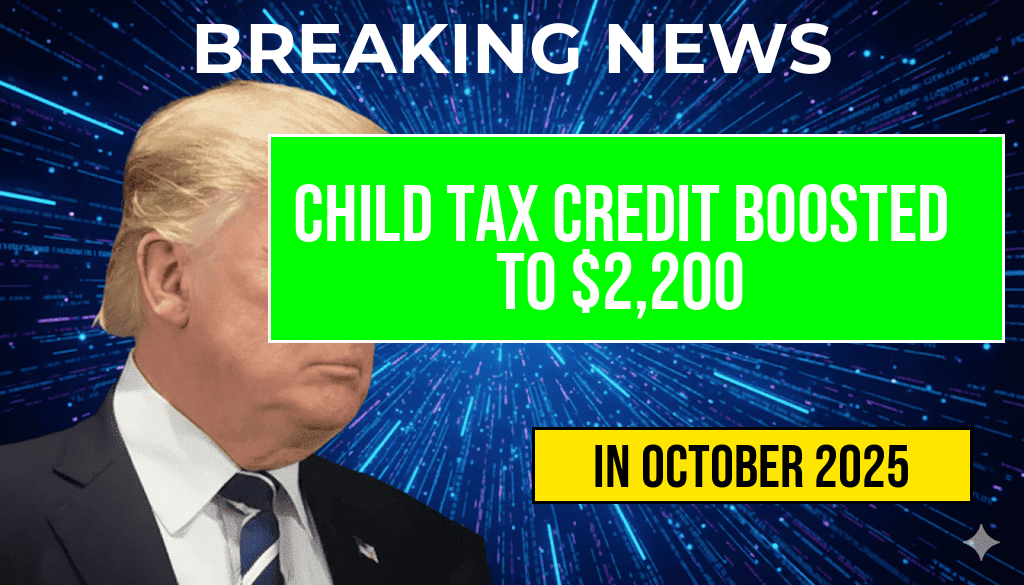The Child Tax Credit (CTC) has undergone a significant boost, increasing to $2,200 per qualifying child, a move that aims to provide more substantial financial relief to millions of American families. This adjustment, part of recent federal policy changes, is expected to impact household budgets across diverse income levels, especially benefiting low- and middle-income households. The increase reflects ongoing efforts to address child poverty and reduce economic disparities, offering families greater support for essentials like childcare, education, and healthcare. The enhanced CTC will be available starting with the upcoming tax season, with eligibility criteria remaining consistent while the increased amount is designed to ensure broader coverage and greater financial stability for families nationwide.
Details of the Increased Child Tax Credit
Scope and Eligibility
- The increased $2,200 credit applies to children under age 17 who meet income and relationship requirements.
- Families earning up to $75,000 annually for individuals and $150,000 for married couples filing jointly are eligible for the full amount, with phased reductions for higher incomes.
- Qualifying children must have a valid Social Security number and reside primarily with the taxpayer for more than half the year.
Payment Structure and Distribution
- The enhanced credit will be delivered as part of annual tax refunds, with some families potentially receiving advance payments throughout the year, similar to prior stimulus measures.
- Taxpayers can claim the credit directly on their IRS filings, with online tools available for eligibility verification and calculations.
- The IRS anticipates that the expanded CTC will benefit approximately 39 million children and their families, reducing child poverty rates significantly.
Impact on Families and Broader Economic Effects
Alleviating Child Poverty
According to recent analyses from the Center on Budget and Policy Priorities, increased child benefits are associated with substantial reductions in child poverty. The boost to $2,200 per child is projected to lift millions above poverty thresholds, providing much-needed financial breathing room for households struggling with rising costs of living.
Supporting Family Well-being
Enhanced financial resources enable families to better afford essentials such as nutritious food, healthcare, and quality education. Social science research indicates that increased income during childhood correlates with improved long-term outcomes, including higher educational attainment and better health indicators.
Economic Stimulus and Consumer Spending
Experts suggest that increased child benefits can stimulate local economies by increasing disposable income. Families are more likely to spend on goods and services, which can contribute to broader economic growth, especially in sectors like retail and childcare services.
Policy Context and Future Outlook
Legislative Background
The recent enhancement to the Child Tax Credit stems from legislative efforts aimed at expanding social safety nets and promoting economic equity. The American Rescue Plan Act of 2021 initially increased the CTC amount and made it fully refundable, leading to a notable decline in child poverty. The current increase to $2,200 continues this trajectory, aligning with longstanding proposals to make child benefits more comprehensive and accessible.
Potential for Long-term Change
Advocates argue that permanent adjustments to the Child Tax Credit could further reduce child poverty and support economic stability for families. Policymakers remain divided on extending these measures beyond temporary relief, with ongoing debates about fiscal responsibility and budget priorities.
Resources and Support for Families
| Aspect | Details |
|---|---|
| Eligibility Criteria | Children under 17, valid SSN, primary residence with taxpayer, income limits |
| How to Claim | File taxes using IRS online portal, use the Child Tax Credit worksheet, or consult a tax professional |
| Additional Resources | IRS Child Tax Credit webpage: https://www.irs.gov/credits-deductions/child-tax-credit |
As families prepare for the upcoming tax season, the increase to the Child Tax Credit signifies a notable step toward broader economic resilience and child welfare. Policymakers and advocacy groups continue to monitor the program’s impact, emphasizing the importance of sustained support to ensure children and their families can thrive amid ongoing economic challenges.
Frequently Asked Questions
What is the new amount for the Child Tax Credit?
The Child Tax Credit has been increased to $2,200 per qualifying child, providing greater financial support to families.
Who is eligible to receive the increased Child Tax Credit?
Families with qualifying children under the age of 17 who meet income and other eligibility requirements can receive the increased Child Tax Credit.
How does the increased Child Tax Credit benefit families?
The increase offers more financial assistance to millions of families, helping cover expenses related to raising children and improving overall household stability.
When will families start to see the increased Child Tax Credit payments?
Eligible families can expect to see the increased payments starting from the upcoming tax season or through advance monthly payments, depending on the current distribution schedule.
Are there any changes to the eligibility criteria for the Child Tax Credit?
Yes, the article details updated eligibility requirements aimed at expanding support to more families, including income limits and qualifying child criteria.






